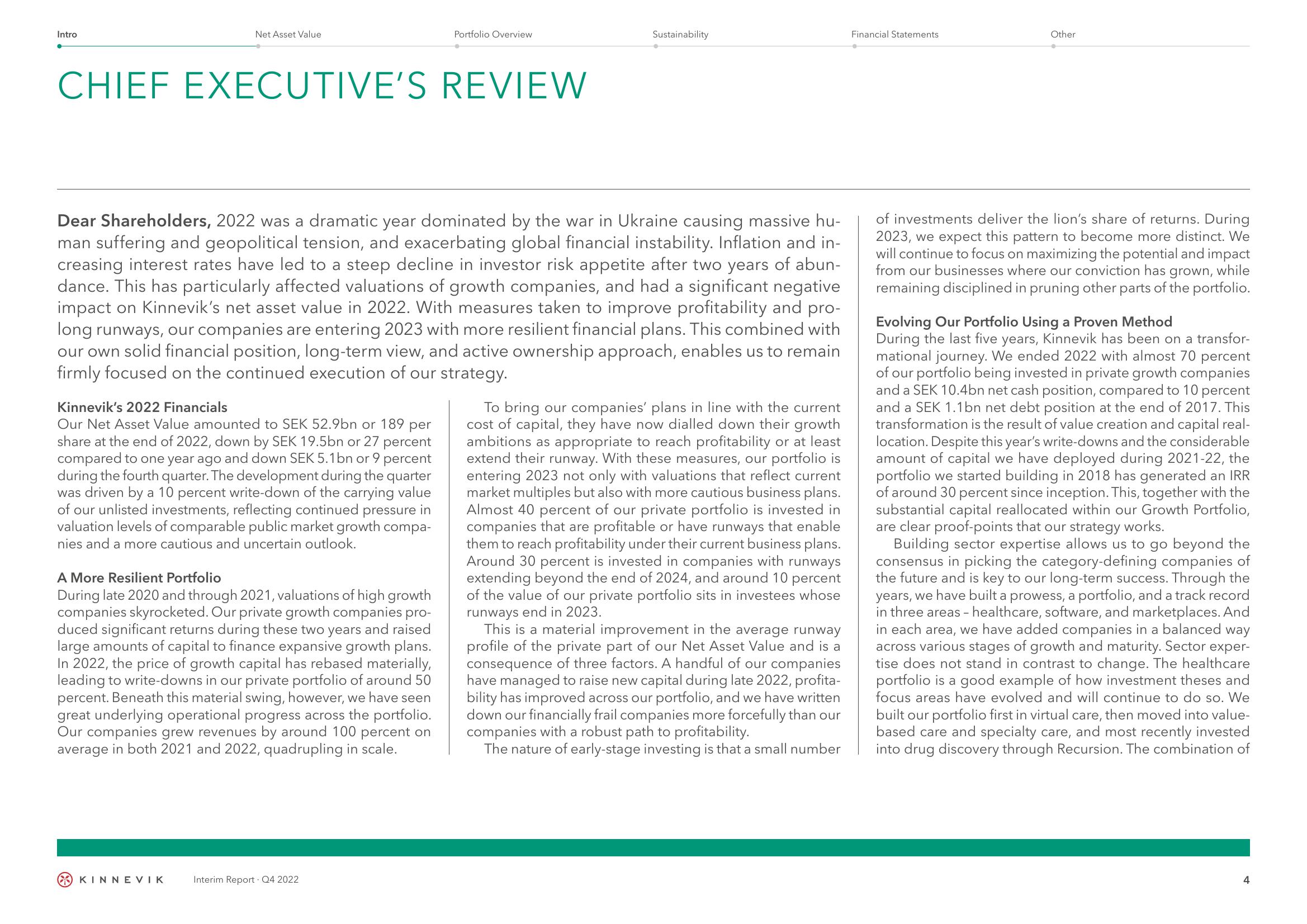Kinnevik Results Presentation Deck
Intro
Net Asset Value
CHIEF EXECUTIVE'S REVIEW
Kinnevik's 2022 Financials
Our Net Asset Value amounted to SEK 52.9bn or 189 per
share at the end of 2022, down by SEK 19.5bn or 27 percent
compared to one year ago and down SEK 5.1 bn or 9 percent
during the fourth quarter. The development during the quarter
was driven by a 10 percent write-down of the carrying value
of our unlisted investments, reflecting continued pressure in
valuation levels of comparable public market growth compa-
nies and a more cautious and uncertain outlook.
Dear Shareholders, 2022 was a dramatic year dominated by the war in Ukraine causing massive hu-
man suffering and geopolitical tension, and exacerbating global financial instability. Inflation and in-
creasing interest rates have led to a steep decline in investor risk appetite after two years of abun-
dance. This has particularly affected valuations of growth companies, and had a significant negative
impact on Kinnevik's net asset value in 2022. With measures taken to improve profitability and pro-
long runways, our companies are entering 2023 with more resilient financial plans. This combined with
our own solid financial position, long-term view, and active ownership approach, enables us to remain
firmly focused on the continued execution of our strategy.
A More Resilient Portfolio
During late 2020 and through 2021, valuations of high growth
companies skyrocketed. Our private growth companies pro-
duced significant returns during these two years and raised
large amounts of capital to finance expansive growth plans.
In 2022, the price of growth capital has rebased materially,
leading to write-downs in our private portfolio of around 50
percent. Beneath this material swing, however, we have seen
great underlying operational progress across the portfolio.
Our companies grew revenues by around 100 percent on
average in both 2021 and 2022, quadrupling in scale.
KINNEVIK
Portfolio Overview
Interim Report. Q4 2022
Sustainability
To bring our companies' plans in line with the current
cost of capital, they have now dialled down their growth
ambitions as appropriate to reach profitability or at least
extend their runway. With these measures, our portfolio is
entering 2023 not only with valuations that reflect current
market multiples but also with more cautious business plans.
Almost 40 percent of our private portfolio is invested in
companies that are profitable or have runways that enable
them to reach profitability under their current business plans.
Around 30 percent is invested in companies with runways
extending beyond the end of 2024, and around 10 percent
of the value of our private portfolio sits in investees whose
runways end in 2023.
This is a material improvement in the average runway
profile of the private part of our Net Asset Value and is a
consequence of three factors. A handful of our companies
have managed to raise new capital during late 2022, profita-
bility has improved across our portfolio, and we have written
down our financially frail companies more forcefully than our
companies with a robust path to profitability.
The nature of early-stage investing is that a small number
Financial Statements
Other
of investments deliver the lion's share of returns. During
2023, we expect this pattern to become more distinct. We
will continue to focus on maximizing the potential and impact
from our businesses where our conviction has grown, while
remaining disciplined in pruning other parts of the portfolio.
Evolving Our Portfolio Using a Proven Method
During the last five years, Kinnevik has been on a transfor-
mational journey. We ended 2022 with almost 70 percent
of our portfolio being invested in private growth companies
and a SEK 10.4bn net cash position, compared to 10 percent
and a SEK 1.1bn net debt position at the end of 2017. This
transformation is the result of value creation and capital real-
location. Despite this year's write-downs and the considerable
amount of capital we have deployed during 2021-22, the
portfolio we started building in 2018 has generated an IRR
of around 30 percent since inception. This, together with the
substantial capital reallocated within our Growth Portfolio,
are clear proof-points that our strategy works.
Building sector expertise allows us to go beyond the
consensus in picking the category-defining companies of
the future and is key to our long-term success. Through the
years, we have built a prowess, a portfolio, and a track record
in three areas - healthcare, software, and marketplaces. And
in each area, we have added companies in a balanced way
across various stages of growth and maturity. Sector exper-
tise does not stand in contrast to change. The healthcare
portfolio is a good example of how investment theses and
focus areas have evolved and will continue to do so. We
built our portfolio first in virtual care, then moved into value-
based care and specialty care, and most recently invested
into drug discovery through Recursion. The combination of
4View entire presentation